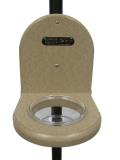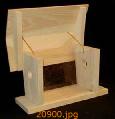
   |
 |
|
|
|
Mealworms are not really worms at all but are the larval form of the darkling beetle (Tenebrio molitor). They are clean, easy to raise, do not carry human diseases and most importantly are a nutritious food supplement readily accepted by bluebirds. Mealworms can be offered to bluebirds to:
Care of Mealworms: Mealworms are easy to raise, requiring only a grain source such as wheat bran, cornmeal, chicken mash or oatmeal. Add a piece of potato, apple or banana peel on a piece of paper towel or cardboard about once a week to provide moisture. Avoid letting the meal itself become too moist. Mealworms can be kept in a shallow plastic container with a capacity of 2 to 5 gallons, that is covered with a lid that provides good air circulation (a cover of screen or perforated metal can be used). Keep the container in the dark, because as the name darkling beetle implies, they prefer darkness. If you plan on raising mealworms, a piece of cloth can be placed over a portion of the grain to provide a surface on which the adult beetles can lay their eggs. The mealworms will burrow below the surface of the grain and undergo a series of molts. Their development is most rapid at the optimum temperature of 80° F. After the last molt, the larvae come to the surface and metamorphose into naked white pupae for 6 - 18 days and then into beetles. Adult beetles have wings but rarely fly. They lay their eggs 9 - 20 days after emergence and then die. Egg incubation is 4-19 days. Eventually, waste products or "frass" will build up and a slight odor of ammonia will be detected. At this time, the grain needs to be sifted to separate the worms and adult beetles from the old grain; the container washed and new grain added. Dry cat food can be added to the grain to enhance the protein value of the mealworms for the bluebirds. Mealworm metabolism can be slowed down by keeping them in the refrigerator for a few weeks, up to several months (remove the vegetable matter first). Feeding Mealworms to Bluebirds: Perhaps the biggest challenge is to try to attract bluebirds to your yard with mealworms. If you already have bluebirds and just want to ensure they stay, mealworms can be an effective enticement. If you have never or rarely seen a bluebird in your yard, chances are they will not show up just because you have put out mealworms. What will happen is that other birds in your yard will find them and quickly consume the entire offering. So unless you have bluebirds around, it could be a costly and unrewarding venture to offer mealworms in the hopes of attracting them. However, in cold climates, small over-wintering songbirds like chickadees, nuthatches, etc. appreciate a small hanging tin cup of mealworms as much as bird watchers enjoy watching them come. There are several types of feeders that can be used, or you can just scatter mealworms on the ground. The latter method is least advised as mealworms are attractive to most birds and they might all be eaten before bluebirds can find them. The best type of feeder is the hopper style where the mealworms can be placed inside the feeder with the bluebirds entering from a hole at either end. Naturally curious, bluebirds will readily explore this type of feeder and quickly recognize it as a food source. The 1 ½" hole at each end will effectively exclude larger birds. Smaller birds will soon catch on, but an aggressive male bluebird will usually defend "his" feeder, especially if he and his mate are nesting nearby. Some find that putting a flat saucer with a few worms in it on top of the hopper feeder will help draw the bluebird's attention to the location of the feeder. Once they become familiar with the routine, the saucer should be removed and mealworms placed inside the feeder. The location of the feeder can also be moved as the birds become familiar with it, and then moved to a spot where it is easier for you to watch them feed. One of the highlights of feeding mealworms to bluebirds is watching the fledged young start coming down to the feeder, first begging to be fed and eventually figuring out for themselves how to get the tasty treats on their own. Because they should be used as a supplemental food, mealworms should only be offered once or twice a day unless poor weather conditions dictate more frequent feeding. A hundred or so worms offered morning and evening would be adequate for a pair with a box of nestlings.
This information has been provided to you by the North American Bluebird Society. Be a part of the conservation solution. Join NABS, The North American Bluebird Society! Contact the NABS headquarters:
Dept. B P.O. Box 74 Darlington WI 53530-0074 Please include a self-addressed stamped envelope for more information. Copyright © 1999 North American Bluebird
Society |
 Bluebird Feeder
Bluebird Feeder
Description: 7/8" Inland Red Cedar for long lasting outdoor use. All screwed construction using weather-resistant plated deck screws, aluminum rust-resistant continuous hinges, and fully routed edges. Two holes in the wood and two holes in the plexy on each side for easy access and escape from predators. Holes are sized for Bluebirds. Dimensions: 14" L x 9" W x 8-1/2" H  |
 Recycled Bluebird Feeder
Recycled Bluebird Feeder
Description: 5/8" Poly-lumber feeder made from recycled plastic and milk jugs; lifetime guarantee to never crack, split or fade. Taupe base w/blue roof. Stainless steel screws; thick, heavy-duty acrylic panels; and aluminum, rust resistant continuous hinges. Two holes in the poly-lumber and two holes in the plexy on each side for easy access and escape from predators. Holes are sized for Bluebirds. Dimensions: 13-1/2"L x 10-1/4" W x 8" H   |
 Recycled Pole-Mounted Mealworm Feeder
Recycled Pole-Mounted Mealworm Feeder
Description: Made from recycled taupe poly-lumber, this feeder comes with pole clamps and a clear cup. Easy to mount and easy to fill and clean. Dimensions: 5 3/8" L x 5 3/4" W x 6 1/4" H   |
 Supper Dome w/Removable Suet Holders
Supper Dome w/Removable Suet Holders
Description: The Supper Dome is constructed out of high-impact polycarbonate with removable coated-wire suet holders. The weather-resistant dome keeps the seed and suet dry and protects the birds while feeding. Dispense the type of seed, feed or suet that attracts the birds that you want to visit your yard. Two separate feeding compartments. You can use the feeder to dispense mealworms, peanuts, sunflower, fruit, jelly, safflower or any blend of seed. The perfect feeder to attract birds to your yard year-round. Includes dome, base and suet log holders. Lifetime guarantee. Dimensions: 10-1/2" L x 13-1/4" H |
 Coveside Bluebird Feeder
Coveside Bluebird Feeder
This feeder is designed to protect not only bluebirds, but all smaller birds. Entrance holes on the end allow little ones in, but keep starlings and other large birds out. Extended landing platform provides outside perches at each end. Bluebirds feed inside on berries and fruit, or mealworms and insects. Top swings up for easy filling. Mount on a post, pole or hang from attached cord. (10-1/2"h x 15"w x 10-3/4"d) |
|
Ads by Google |

Home
Page |
Product Review Page | Help
 Woodside Gardens
The Registry of Nature Habitats
Woodside Gardens
The Registry of Nature Habitats 
 1999 -
1999 -
All Rights Reserved
Last Updated: